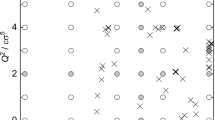Abstract
The corresponding states principle (CSP) and the extended CSP have proven to be valuable tools in the prediction of properties of fluids and fluid mixtures. However, the accuracy of the application of these principles to property prediction is crucially dependent on the accuracy of the equation of state of the reference fluid or fluids involved. In this work, a new methodology of property prediction is developed and discussed. The revised extended corresponding states method, as developed by Marrucho and Ely, is combined with a reformulated (Teja-like) Lee–Kesler approach. The reformulated Lee–Kesler method is used to generate a pseudo-reference fluid, specific to each target fluid, which allows better mapping characteristics with any specified target fluid. This methodology is tested for the prediction of bulk volumetric properties of non-polar as well as polar fluids (specifically, alternative refrigerants). The results with different pseudo-reference fluids are compared with those of the original Lee–Kesler model and those obtained with n-propane as a single reference fluid. In the case of polar fluids, the prediction of properties is improved if the Taylor series expansion of the compressibility factor in the Lee–Kesler approach is affected in terms of the dipole moment rather than the acentric factor. The details of the combined “reformulated Lee–Kesler extended corresponding states” methodology are elucidated.
Similar content being viewed by others
REFERENCES
R. T. Jacobsen and R. B. Stewart, J. Phys. Chem. Ref. Data 2:757 (1973).
K. S. Pitzer, D. Z. Lippmann, R. F. Curl, Jr., C. M. Huggins, and D. E. Petersen, J. Am. Chem. Soc. 40:3433 (1955).
K. S. Pitzer, J. Am. Chem. Soc. 77:3427 (1955).
K. S. Pitzer, and R. F. Curl, Jr, J. Am. Chem. Soc. 79:2369 (1957).
B. I. Lee and M. G. Kesler, AIChE J. 21:510 (1975).
A. S. Teja and P. Rice, Chem. Eng. Sci. 36:1 (1981).
A. S. Teja, S.I. Sandler, and N. C. Patel, Chem. Eng. J. 21:21 (1981).
R. A. Mentzner, K. L. Young, R. A. Greenkorn, and K. C. Chao, Sep. Sci. Tech. 15:1613 (1980).
J. F. Ely, Adv. Cryo. Eng. 35:1520 (1990).
G. Z. A. Wu and L. I. Stiel, AIChE J. 31:1632 (1985).
W. V. Wilding, J. K. Johnson, and R. L. Rowley, Int. J. Thermophy. 8:717 (1987).
D. L. Morgan and R. Kobayashi, Fluid Phase Equil. 94:51 (1987).
M. Benedict, G. B. Webb and L. C. Rubin, J. Chem. Phys. 8:334 (1940).
R. V. Orye, I & EC Proc. Design & Develop. 8:579 (1969).
J. Nohka, E. Sarashina, Y. Arai, and S. Saito, J. Chem. Eng. Japan 6:10 (1973).
S. I. Stanley and H. Orbey, Equations of State for Fluids and Fluid Mixtures, Experimental Thermodynamics, Vol. 5 (Elsevier, Amsterdam, 2000).
P. S. Fialho and C. A. Nieto de Castro, Int. J. Thermophys. 21:385 (2000).
J. F. Ely and A. S. Cullick, J. Chem. Eng. Data 27:276 (1992).
A. A. Frost and D. R. Kalkwarf, J. Chem. Phys. 21(3):264 (1953).
H. G. Rackett, J. Chem. Eng. Data 15:514 (1970).
I. M. Marrucho, “Extended Corresponding States Theory: Application for Polar Compounds and Their Mixtures,” Ph.D. Thesis, Instituto Superior Técnico, Portugal (1996).
I. M. Marrucho and J. F. Ely, Fluid Phase Equil. 215:150 (1999).
James F. Ely and Isabel M. Marrucho, Equations of State for Fluids and Fluid Mixtures, Experimental Thermodynamics, Vol. 5 (Elsevier, Amsterdam, 2000).
J. Xu and D. R. Herschbach, J. Phys. Chem. 96: 2307 (1992).
E. Holleran, Ind. Eng. Chem. Res. 29:632 (1990).
G. Parsafar and E. A. Mason, J. Chem. Phys. 97:9048 (1993).
U. V. Mardolcar and C. A. Nieto de Castro, ”1st Workshop on Thermochemical, Thermophysical and Transport Properties of Halogenated Hydrocarbons and Mixtures,” Oral Communication, Pisa, 15–18 December, 1999.
Author information
Authors and Affiliations
Rights and permissions
About this article
Cite this article
Pai-Panandiker, R.S., Nieto de Castro, C.A., Marrucho, I.M. et al. Development of an Extended Corresponding States Principle Method for Volumetric Property Predictions Based on a Lee–Kesler Reference Fluid. International Journal of Thermophysics 23, 771–785 (2002). https://doi.org/10.1023/A:1015419607914
Issue Date:
DOI: https://doi.org/10.1023/A:1015419607914




